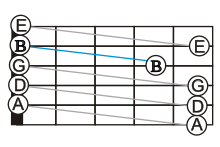All fifths tuning
| All fifths | |
|---|---|
Trivial (0) | |
| Minor thirds (3) | |
| Major thirds (4) | |
| All fourths (5) | |
| Augmented fourths (6) | |
| New standard (7, 3) | |
| All fifths (7) | |
| Minor sixths (8) | |
| Guitar tunings |


Among
- E-A-d-g-b-e'
All-fifths tuning has the set of open strings
- C-G-d-a-e'-b' or G'-D-A-e-b-f♯',
which have intervals of 3 octaves minus a half-step between the lowest and highest string. The conventional tuning has an interval of 2 octaves between lowest and highest string.
All-fifths tuning is a tuning in intervals of perfect fifths like that of a mandolin or a violin. It has a wide range. It was used by jazz guitarist Carl Kress in the form
- B♭'-F-c-g-d'-a'.[2]
An approximation: new standard tuning
All-fifths tuning has been approximated with tunings that avoid the high b' replacing it with a g' in the
An approximation: through the looking glass guitar
All-fifths tuning has been approximated with tunings in the Through The Looking Glass Guitar[6] of Kei Nakano, which has been played by him since 2015. This new tuning is like a mirror to all kinds of string instruments including guitar. Also it can adapt to any other tunings of guitar. If tuned to normal guitar for the right handed person, it is able to use for lefty guitar in general, and vice versa.
Relation with all-fourths tuning
All-fifths tuning is closely related to
See also
- All fourths
- Perfect fifth
- Guitar tunings
Notes
- ^ Sethares (2001, "The mandoguitar tuning" 62–63): Sethares, Bill (2001). "Regular tunings". Alternate tuning guide (PDF). Madison, Wisconsin: University of Wisconsin; Department of Electrical Engineering. pp. 52–67. 2010 Alternate tuning guide, including a revised chapter on regular tunings. Retrieved 19 May 2012.
- ^ Page 92. Richard Lieberson, "Swing guitar: The acoustic chordal style", pages 89-112. The Guitar in Jazz: An Anthology, Edited by James Sallis. 1996. 978-0-8032-4250-0
- on 26 October 2011, retrieved 25 March 2012
- National Public Radio. Retrieved 25 March 2012..
- Skupartitas001.
- ^ "日本特許第6709929号 【発明の名称】弦楽器 【特許権者】中野 圭". patents.google.com. Retrieved 2023-06-30.
- ^ Sethares (2001, p. 53)
References
- Sethares, William A. (2011). "Alternate tuning guide". Madison, Wisconsin: University of Wisconsin; Department of Electrical Engineering. 2010 PDF version by Bill Sethares. Retrieved 19 May 2012.
Further reading
- Denyer, Ralph (1992). "Playing the guitar: Alternative tunings". The guitar handbook. Special contributors Isaac Guillory and Alastair M. Crawford (Fully revised and updated ed.). London and Sydney: Pan Books. pp. 158–159. ISBN 0-330-32750-X.
